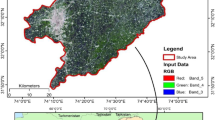Abstract
The accurate classification of the fragments is a critical step in the restoration of the Terracotta Warriors. However, the traditional manual-based method is time-consuming and labor-intensive, and the accuracy mainly depends on the archeologist’s experience. In this paper, we present a novel classification framework for the 3D Terracotta Warriors fragments. The core of our framework is a dual-modal based neural network, which can incorporate geospatial and texture information of the fragments and output the category of each fragment. The geospatial information is extracted from the point cloud directly. At the same time, a method based on the 3D mesh model and improved Canny edge detection algorithm is proposed to extract the texture information. As to the real-world data experiments, the dataset includes 800 pieces of the arm, 810 pieces of the body, 810 pieces of head and 830 pieces of leg, and the mean accuracy rate is 91.41%, which is better than other existing methods, which only based on geospatial information or texture information. We hope our framework can provide a useful tool for the virtual restoration of the Terracotta Warriors.
Graphic abstract







Similar content being viewed by others
References
Gao H, Geng G (2019) Classification of 3D terracotta warrior fragments based on deep learning and template guidance. IEEE Access 8:4086
Griffiths D, Boehm J (2019) A review on deep learning techniques for 3D sensed data classification. Remote Sens 11(12):1499
Kampel M et al. (2001) Classification of archaeological fragments using profile primitives. In: Proceedings of the 25th workshop of the austrian association for pattern recognition, na
Kampel M, Sablatnig R (2000) Color classification of archaeological fragments. In: Proceedings 15th international conference on pattern recognition. ICPR-2000, IEEE
Kang X et al (2015) Classification of cultural relic fragments based on salient geometric features. J Graphics 36(4):551–556
Karasik A, Smilansky U (2011) Computerized morphological classification of ceramics. J Archaeol Sci 38(10):2644–2657
Kingma DP, Ba J (2014) Adam: a method for stochastic optimization. arXiv preprint arXiv:1412.6980
Li Y et al. (2018) Pointcnn: Convolution on x-transformed points. In: Advances in neural information processing systems
Liu X (2019) Research on residual network identification and multi-feature mosaic technology for cultural relics restoration School of Information Science and Technology Northwest University. Master Thesis
Li-Ying Q, Ke-Gang W (2010) Kernel fuzzy clustering based classification of ancient-ceramic fragments. In: 2010 2nd IEEE international conference on information management and engineering, IEEE
Maturana D, Scherer S (2015) Voxnet: a 3d convolutional neural network for real-time object recognition. In: 2015 IEEE/RSJ international conference on intelligent robots and systems (IROS), IEEE
Moenning C, Dodgson NA (2003) A new point cloud simplification algorithm. In: Proc. int. conf. on visualization, imaging and image processing
Qi CR et al. (2016) Volumetric and multi-view cnns for object classification on 3d data. In: Proceedings of the IEEE conference on computer vision and pattern recognition
Qi CR et al. (2017) Pointnet: deep learning on point sets for 3d classification and segmentation. In: Proceedings of the IEEE conference on computer vision and pattern recognition
Qi CR et al. (2017) Pointnet ++: deep hierarchical feature learning on point sets in a metric space. In: Advances in neural information processing systems
Smith P et al. (2010) Classification of archaeological ceramic fragments using texture and color descriptors. In: 2010 IEEE computer society conference on computer vision and pattern recognition-workshops, IEEE
Su H et al. (2015) Multi-view convolutional neural networks for 3d shape recognition. In: Proceedings of the IEEE international conference on computer vision
Szegedy C et al. (2017) Inception-v4, inception-resnet and the impact of residual connections on learning. In: Thirty-first AAAI conference on artificial intelligence
Wang, Y. (2019). Research on the classification algorithm of terracotta warrior fragments based on the optimization model of convolutional neural network. School of Information Science and Technology, Northwest University. Master Thesis
Wang Q, Kim M-K (2019) Applications of 3D point cloud data in the construction industry: a fifteen-year review from 2004 to 2018. Adv Eng Inform 39:306–319
Wu Z et al. (2015) 3d shapenets: a deep representation for volumetric shapes. In: Proceedings of the IEEE conference on computer vision and pattern recognition
Xie Y et al. (2019) A review of point cloud semantic segmentation. arXiv preprint arXiv:1908.08854
Yang W et al. (2017) Classification of terra-cotta warriors fragments based on multi-feature and SVM. J Northwest Univ,
Zhao F, Geng G (2018) Fragments classification method of terracotta warriors based on region and shape features. J Geomat Sci Technol 35(6):584–588
Zhou P et al. (2011) Ancient porcelain shards classifications based on color features. In: 2011 Sixth international conference on image and graphics, IEEE
Acknowledgements
This work was supported in part by the National Natural Science Foundation of China under Grant 61701403, the Project funded by China Post-doctoral Science Foundation under Grant No. 2018M643719, the Young Talent Support Program of the Shaanxi Association for Science and Technology under Grant No.20190107, the National Key Research and Development Program of China under Grant 2017YFB1402103, the Scientific Research Program Funded by Shaanxi Provincial Education Department under Grant No. 18JK0767, and the Natural Science Research Plan Program in Shaanxi Province of China 2017JQ6006.
Author information
Authors and Affiliations
Corresponding authors
Additional information
Publisher's Note
Springer Nature remains neutral with regard to jurisdictional claims in published maps and institutional affiliations.
Rights and permissions
About this article
Cite this article
Yang, K., Cao, X., Geng, G. et al. Classification of 3D terracotta warriors fragments based on geospatial and texture information. J Vis 24, 251–259 (2021). https://doi.org/10.1007/s12650-020-00710-6
Received:
Revised:
Accepted:
Published:
Issue Date:
DOI: https://doi.org/10.1007/s12650-020-00710-6




